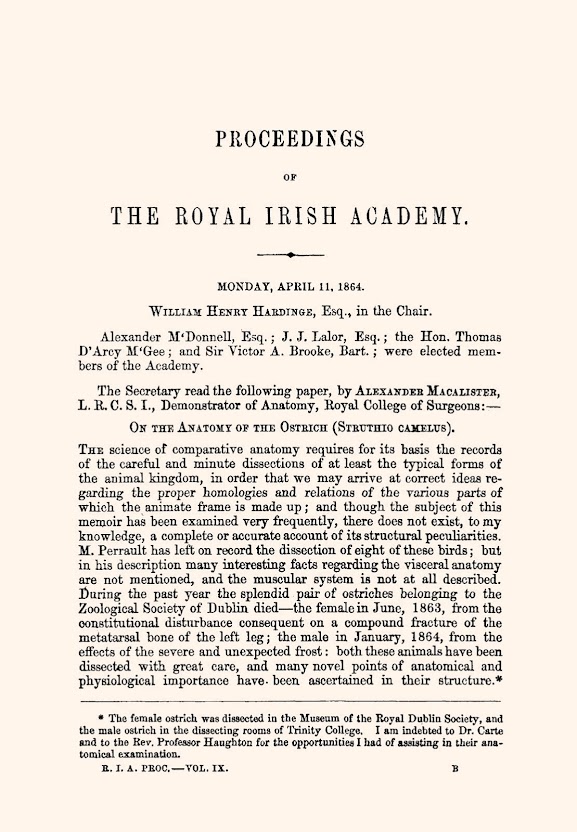Content
Fragment of the article: Macalister A. On the anatomy of the ostrich (Struthio camelus) (1864). The author observed ligamentum capitis femoris (LCF) in an ostrich. Its strength is noted, and its shape is described. Translation into Russian is available at the link: 1864MacalisterA.
Quote, p. 22
The articulations of the lower extremity present many
points of mechanical importance. The first, or the hip, is an enarthrosis, surrounded
by a capsule, loose, expanding inferiorly; the synovial membrane spreads over
the great trochanter; a strong transverse band passes from the border of the
lesser sciatic notch to the upper and posterior edge of the acetabulum, under
which the articular vessels pass to the joint. An extremely strong ligamentum
teres passes downwards, outwards, and forwards, from the lower border of the
cotyloid cavity, and is inserted into
the upper part of a depression on the head of the femur, near which it is cylindrical; at its, origin
it is flattish and expanded; a cotyloid
ligament protects the superior and anterior edge of the joint; thick and cartilaginous above, thin and
membranous below and in front The bottom
of the cavity is separated from the air cells by a membrane consisting of fibres running
downwards and forwards, and some
radiating.
Quote, p. 22
Die Gelenke der unteren Extremität weisen viele mechanisch wichtige Punkte auf. Die Hüfte ist eine Enarthrose, umgeben von einer lockeren, sich nach unten ausdehnenden Kapsel; die Synovialmembran breitet sich über den großen Rollhügel aus; ein starkes Querband verläuft vom Rand der kleinen Ischiaskerbe zum oberen und hinteren Rand der Hüftpfanne, unter der die Gelenkgefäße zum Gelenk verlaufen. Ein extrem starkes Ligamentum teres verläuft vom unteren Rand der Hüftpfanne nach unten, außen und vorne und setzt im oberen Teil einer Vertiefung am Oberschenkelkopf an, in dessen Nähe es zylindrisch ist; an seinem Ursprung ist es flach und ausgedehnt; ein Ligamentum cotyloideum schützt den oberen und vorderen Rand des Gelenks; oben dick und knorpelig, unten und vorne dünn und häutig. Der Boden der Pfanne ist von den Luftzellen durch eine Membran getrennt, die aus nach unten und vorne verlaufenden und teilweise strahlenförmigen Fasern besteht.
Macalister A. On the anatomy of the ostrich (Struthio camelus). Proceedings of the Royal Irish Academy (1836-1869). 1864;9:1-24. jstor.org
Alexander
Macalister (1844-1919), was an Irish anatomist,
Professor of Anatomy, Cambridge University. wikipedia.org
 |
| Alexander Macalister Author unknown; original in the wikimedia.org collection (CC0 – Public Domain, color correction). |
ligamentum capitis femoris, ligamentum
teres, ligament of head of femur, anatomy, mechanical properties, birds,
animals, synonym, form
NB! Fair practice / use: copied for the purposes of criticism, review, comment, research and private study in accordance with Copyright Laws of the US: 17 U.S.C. §107; Copyright Law of the EU: Dir. 2001/29/EC, art.5/3a,d; Copyright Law of the RU: ГК РФ ст.1274/1.1-2,7


Comments
Post a Comment